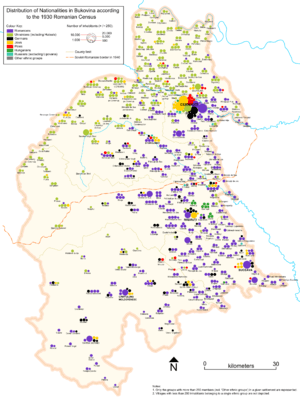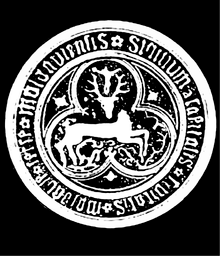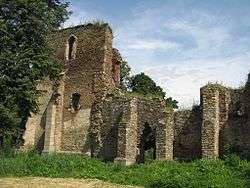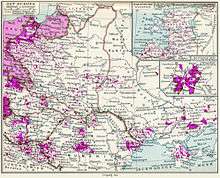Bukovina Germans

The Bukovina Germans are a German ethnic group who had a noteworthy demographic presence (spanning from c. 1780 to 1940) in the historic Central European region of Bukovina, which is nowadays divided between northeastern Romania and western Ukraine.
During the early and mid-early 20th century, they represented a minority of approximately 21 percent of the multiethnic population of the Duchy of Bukovina, according to a 1910 census (with more Jews than Christians), until the Holocaust and the resettlement of the Christian population into the German Reich after the Molotov–Ribbentrop Pact in autumn 1940.
History
Middle Ages


Ethnic Germans known as Transylvanian Saxons (who were mainly craftsmen and merchants stemming from present-day Luxembourg and Rhine-Moselle areas of Western Europe), had sparsely settled in the western mountainous regions of the Principality of Moldavia over the course of the late medieval Ostsiedlung migration (which, in this particular case, took place throughout the 13th and 14th centuries).
These settlers encouraged trade and urban development. Additionally, they founded (and were also briefly in charge under the title of Schultheiß) of some notable medieval settlements such as Baia (Stadt Molde/Moldenmarkt), the first capital of the Principality of Moldavia, or Târgu Neamț (Niamtz).[1] Subsequently, they were assimilated in these local cultures.
Modern Age and Habsburg rule
Following the Russo-Turkish War, in 1774–75 the Habsburg Monarchy annexed northwestern Moldavia which was predominantly inhabited by Romanians (as many as 85 percent), with smaller numbers of Ukrainians (including Hutsuls and Ruthenians), Armenians, Poles, and Jews.[2]
Since then, the region has been known as Bukovina (German: Bukowina or Buchenland). From 1774 to 1786, settlement of German craftsmen and farmers in existing villages increased (see also: Josephine colonization). The settlers included Zipser Germans from the Zips region of Upper Hungary (present-day Slovakia), Banat Swabians from Banat, and ethnic Germans from Galicia (Protestants), but also immigrants from the Rhenish Palatinate, the Baden and Hesse principalities, as well as from impoverished regions of the Bohemian Forest.
Thus, four distinct German linguistic groups were represented as follows:
- Austrian High German (Österreichisches Hochdeutsch) was spoken in urban centres like Chernivtsi (Czernowitz), Rădăuți (Radautz), Suceava (Suczawa), Gura Humorului (Gura Humora), Câmpulung (Kimpolung), and Siret (Sereth);
- Bohemian-Bavarian German (Deutschböhmisch/Böhmerwäldisch) was spoken by woodsmen in Althütte, Neuhütte, Karlsberg, Fürstenthal, Schwarzthal, Buchenhain, Dealu Ederii (Lichtenberg), Bori (early colony in Gura Humorului), and Clit (Glitt);
- Palatine Rhine Franconian (Pfälzisch) was spoken in farming villages like Arbora, Deutsch Badeutz, Alt Fratautz, Neu Fratautz, Illischestie, Itzkany, Deutsch Satulmare and Tereblestie;
- Zipser German (Zipserisch) was spoken by mine workers and their descendants in Cârlibaba (Mariensee), Iacobeni (Jakobeny), Stulpicani (Stulpikany), and elsewhere.[3]
During the 19th century, the developing German middle class comprised much of the intellectual and political elite of the region; the language of official business and education was predominantly German, particularly among the upper classes. Population growth and a shortage of land led to the establishment of daughter settlements in Galicia, Bessarabia, and Dobruja.
After 1840, a shortage of land caused the decline into poverty of the German rural lower classes; in the late 19th century parts of the German rural population alongside a few Romanians emigrated to the Americas, mainly to the United States (most notably to Kansas) but also to Canada.[4][5][6]
Between 1849 and 1851, and from 1863 to 1918, the Duchy of Bukovina became an independent crown land within the Austrian Empire (see also: Cisleithania). However, in comparison to other Austrian crown lands, Bukovina remained an underdeveloped region on the periphery of the realm, primarily supplying raw materials.
The Franz-Josephs-Universität in Czernowitz was founded in 1875, then the easternmost German-speaking university. In 1910–1911, the Bukovinan Reconciliation (a political agreement between the peoples of Bukovina and their political representatives in the Landtag assembly on the question of autonomous regional administration) took place between the representatives of the nationalities.
 Cernăuți (Czernowitz) town hall, c. 1905
Cernăuți (Czernowitz) town hall, c. 1905.jpg)
 Roman Catholic church in Gura Humorului (Gura Humora), early 20th century
Roman Catholic church in Gura Humorului (Gura Humora), early 20th century.jpg) View of Iacobeni (Jakobeny), a Zipser German village, early 20th century
View of Iacobeni (Jakobeny), a Zipser German village, early 20th century Bilingual German-Romanian postcard from Vatra Dornei (Dorna-Watra), early 20th century
Bilingual German-Romanian postcard from Vatra Dornei (Dorna-Watra), early 20th century
Early 20th century and Kingdom of Romania

From 1918 to 1919, following the end of World War I and the dissolution of the Austro-Hungarian Empire, Bukovina became part of the Kingdom of Romania. At the General Congress of Bukovina held on November 28, 1918,[7] the political representatives of the Bukovina Germans voted and supported the union of Bukovina with the Romanian kingdom, alongside the Romanian and Polish representatives.
From 1933–1940, some German societies and organisations opposed the propaganda of the Third Reich and the National Socialist-aligned "Reformation Movement". Beginning in 1938, due to the poor economic situation and Nazi propaganda, a pro-Reich mentality developed among the German population. Because of this, many increased their preparedness for evacuation.
Resettlement

When Nazi Germany signed the German-Soviet Non-Aggression Pact with the Soviet Union in 1939 before the outbreak of World War II, the fate (unknown to those affected) of the Germans in Bukovina was sealed. In a secret supplementary protocol, it was agreed (among other things) that the northern part of Bukovina would be annexed by the USSR under a territorial reorganisation in Eastern Europe, with the German sub-populations undergoing compulsory resettlement. Under this accord, the Soviet Union occupied northern Romania in 1940.
The Third Reich resettled nearly the entire German population of Bukovina (about 96,000 ethnic Germans) to (among other places) Poland, where the incoming evacuees were frequently compensated with expropriated farms. From 1941 to 1944, Bukovina was entirely Romanian. Most of the Jewish population (30% of the population as a whole) were murdered by the Third Reich and Romania during the Holocaust.
1944 flight and recommencement
In 1944–45, as the Russian front moved closer, the Bukovina Germans settled in Polish areas (like the remaining German population), fled westward or wherever they could manage. Some remained in East Germany; others went to Austria. In 1945, the 7,500 or so remaining Germans in Bukovina were evacuated to Germany, ending (except for a few individuals) the German presence in Bukovina after 1940. During the postwar era the Bukovina Germans, like other "homeland refugees", assimilated into the Federal Republic, Austria or the German Democratic Republic.[8]
Demographics
At the 1930 census there were 75,000 ethnic Germans counted in Bukovina.[9] Thus, the Bukovina Germans made up to 12.46% of the total population of the county of Suceava at that time. As per the 2011 Romanian census, the German minority in southern Bukovina makes up to only 0.11% of the total population (including Zipsers and Regat Germans).[10]
Organisations
The political representation of the Bukovina Germans and of all other German-speaking groups in modern Romania is the DFDR/FDGR (German: Demokratisches Forum der Deutschen in Rumänien, Romanian: Forumul Democrat al Germanilor din România).
After the Second World War, the Bukovina Germans founded the Landsmannschaft der Buchenlanddeutschen (Bundesrepublik Deutschland) (Homeland Association of the Bukovina Germans in the Federal Republic of Germany).
Notable people
- Joseph Weber, Roman Catholic prelate
- Elisabeth Axmann, writer
- Stefan Baretzki, Auschwitz guard who murdered more than 8,000 people
- Franz Des Loges, former mayor of Suceava
- Anton Keschmann, politician in the Imperial Austrian Parliament
- Ludovic Iosif Urban Rudescu, biologist
- Francisc Rainer, physiologist and anthropologist
- Alfred Eisenbeisser, professional footballer
- Lothar Würzel, journalist, linguist, and politician
- George Ostafi, abstract painter
- Stefan Hantel (partly Bukovina German), musician
- Viktor Pestek, Auschwitz guard who helped a prisoner escape, for which he was executed in 1944
- Gregor von Rezzori (partly Bukovina German), writer
- Ludwig Adolf Staufe-Simiginowicz (partly Bukovina German), poet
- Olha Kobylianska (partly Bukovina German), writer
- Constantin Schumacher (partly German), professional footballer
See also
References
- ↑ Hugo Weczerka, Das mittelalterliche und frühneuzeitliche Deutschtum im Fürstentum Moldau, München 1960
- ↑ Keith Hitchins. The Romanians 1774-1866. Oxford: Clarendon Press (1996), pp. 226
- ↑ Willi Kosiul, Die Bukowina und ihre Buchenlanddeutschen (2012, ISBN 3942867095), volume 2
- ↑ "Bukovina Society of the Americas Home Page". Bukovinasociety.org. Retrieved 2013-03-26.
- ↑ "Bukovina Germans". Freepages.genealogy.rootsweb.com. Retrieved 2013-03-26.
- ↑ "Bukovina Immigration to North America". Bukovinasociety.org. Retrieved 2013-03-26.
- ↑ Irina Livezeanu (2000). Cultural Politics in Greater Romania: Regionalism, Nation Building & Ethnic Struggle, 1918-1930. Cornell University Press. pp. 59–. ISBN 0-8014-8688-2.
- ↑ Welisch Sophie (1984). "The Second World War resettlement of the Bukovina‐Germans". Immigrants. 3: 49–68. doi:10.1080/02619288.1984.9974569.
- ↑ Hannelore Baier, Martin Bottesch, u. a.: Geschichte und Traditionen der deutschen Minderheit in Rumänien (Lehrbuch für die 6. und 7. Klasse der Schulen mit deutscher Unterrichtssprache). Mediaș 2007, S. hier 19-36.
- ↑ Rezultatele finale ale Recensământului din 2011: „Tab8. Populația stabilă după etnie – județe, municipii, orașe, comune". Institutul Național de Statistică din România. (July, 2013) - http://www.recensamantromania.ro/wp-content/uploads/2013/07/sR_Tab_8.xls